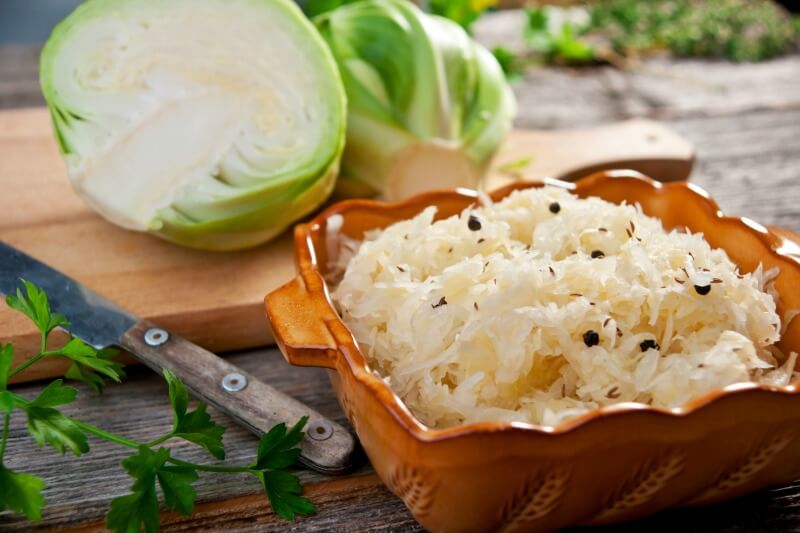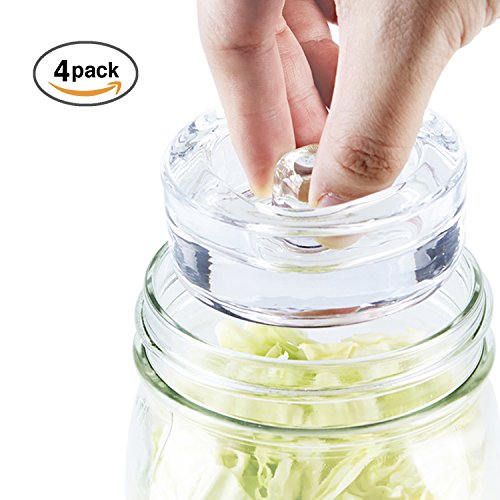Before refrigeration, people developed various methods of preserving harvested foods for later, such as drying, smoking, salting, jarring, canning, and pickling. Through fermenting shredded cabbage in a salty solution called brine, people can enjoy delicious sauerkraut for months after the cabbage is harvested. Let’s take a look at the science of sauerkraut to understand how it’s made.

The Science Of Sauerkraut
Fermenting cabbage for long term storage was very popular before refrigerators came along. Here’s a method you can use at home to turn heads of cabbage into tasty sauerkraut.
Ingredients for making sauerkraut
- 5 pounds of shredded cabbage (about 2 heads)
- 3 tbsp. pickling, sea, or kosher salt
- glass bowl
- a crock or a food-grade plastic bucket
- wooden spoon or potato masher
- a plate and some heavy rocks or other weight
TSM Products 31060 German Style Fermentation Harvest Pot with Stone Weight, 5-Liter 4-Pack of Fermentation Glass Weights with Easy Grip Handle for Wide Mouth Mason Jar
4-Pack of Fermentation Glass Weights with Easy Grip Handle for Wide Mouth Mason Jar Weston Cabbage Shredder (70-1401-W), Stainless Steel Blades, Shreds 7mm Strips, Easy Grip & Clean Up
Weston Cabbage Shredder (70-1401-W), Stainless Steel Blades, Shreds 7mm Strips, Easy Grip & Clean Up
How to make fermented sauerkraut
- Remove outer cabbage leaves, wash each cabbage head, and cut it into fourths. Remove the cores and throw them in the compost bin. Then shred the cabbage fourths.
- Dump shredded cabbage into a glass bowl with the salt and mix everything together gently but thoroughly with your hands.
- Dump the mixture into your crock or bucket and mash and pound it with your wooden spoon or potato masher. Continue until water from the bruised cabbage mixes with the salt to create a brine solution.
- Cover the mixture with the plate and weigh the plate down with rocks.
- Leave at a cool room temperature (between about 69-72º) for 2 days. Check and then skim off any white scum that may have formed on top. (Don’t worry! The scum is harmless.)
- Continue checking and skimming scum every 3 days for about 2 weeks. Then taste to see if it is ready. (If it ever turns dark brown, it has gone bad.)
- Unless you can or jar it, store finished sauerkraut in a very cool place such as your refrigerator or a dark cellar, and eat it all within a few weeks. If it tastes too salty, rinse portions before eating. Note how the flavor matures as the sauerkraut ages.
Talking to your kids about the process of making sauerkraut
Note that methods of preservation variety from place to place and time to time based on factors such as climate and the level of technology available to a culture.
Easy Fermenter Wide Mouth Lid Kit: Simplified Fermenting In Jars Not Crock Pots! Make Sauerkraut, Kimchi, Pickles Or Any Fermented Probiotic Foods. 3 Lids, Extractor Pump & Recipe eBook – Mold Free Over 2000 years ago the Chinese were preserving cabbage with rice wine as kimchi. After invading China around 1000 years after this, Genghis Khan spread this dish to Eastern Europe, where people substituted salt for the wine and labeled the food sauerkraut, or “sour cabbage.” Later, Dutch and German immigrants brought this food to America.
Over 2000 years ago the Chinese were preserving cabbage with rice wine as kimchi. After invading China around 1000 years after this, Genghis Khan spread this dish to Eastern Europe, where people substituted salt for the wine and labeled the food sauerkraut, or “sour cabbage.” Later, Dutch and German immigrants brought this food to America.
Fermentation works by allowing “good” bacteria to grow and stop bad bacteria that would make the food rot from growing. Any fermented food is made by combining water with a fermenting agent such as vinegar or salt, and then letting the mixture sit for days or weeks to ferment.
In particular, sauerkraut forms when “good” bacteria turn the sugars in cabbage into lactic acid, a substance which preserves the cabbage by keeping “bad” bacteria from growing and rotting the food or making people who eat it sick. The good bacteria do not have to be added to sauerkraut because they already exist on raw cabbage.





